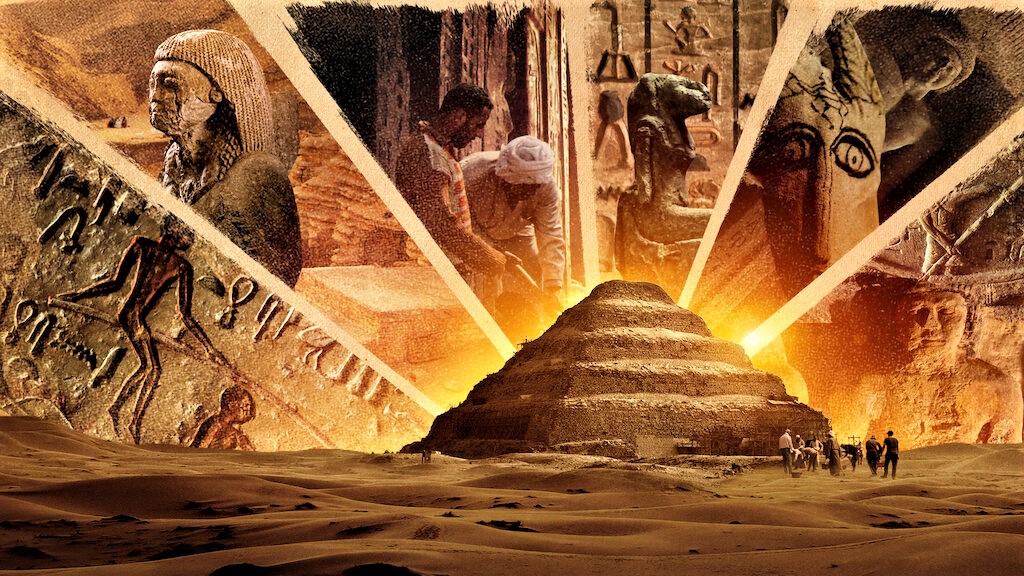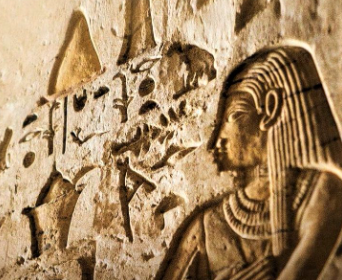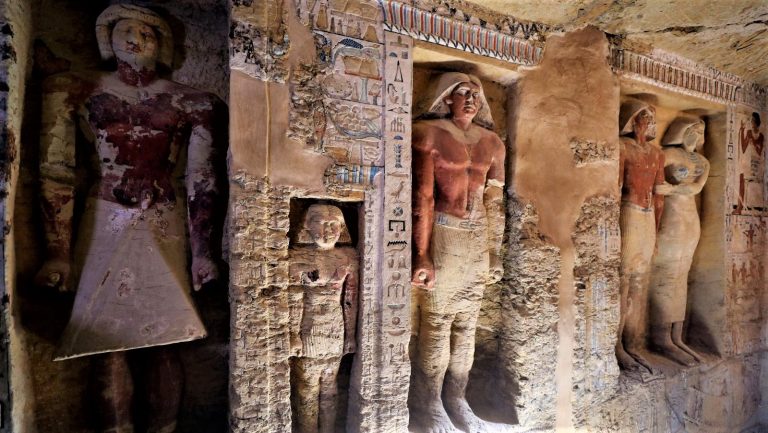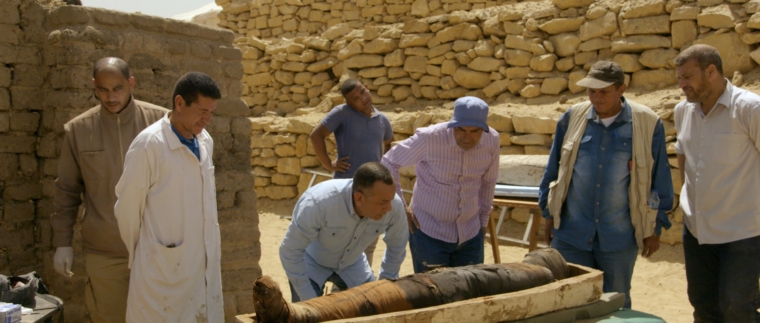“Secrets of the Saqqara Tomb” is a new documentary which takes audiences along for an exciting journey after an Egyptian excavation team unearths a tomb that had been untouched for 4,400 years. As they attempt to decipher the history of their breathtaking finds, the film reveals new aspects of ancient Egyptian life.

Secrets of the Saqqara Tomb (Credit: Netflix Official Site)
The DocumentaryThe mysteries uncovered in “Secrets of the Saqqara Tomb”[i] made headlines across the world in 2019: the discovery of an untouched 4,400-year-old tomb of a man named Wahtye at the Saqqara necropolis[ii], 19 miles (30 km) from Cairo, containing scores of mummified animals, including a lion cub, and 3,109 unique artifacts. The Egyptian team unearthed the findings over the course of six weeks of intensive excavation.
The group included dozens of laborers as well as experts in Egyptology, rheumatology, and archaeozoology, who not only discovered Wahtye’s tomb – shinning light on his life and plight – but also found the remains of Wahtye’s family. More importantly, they concluded that the whole family died of Malaria. If verified, it will be the earliest documented case of malaria in history by more than 1,090 years. The mummified lion cub found by the team has since been confirmed as the first ever discovered in history.
Yet, the documentary’s real revelation is its focus on the team of relentless Egyptian archaeologists who do their job with dedication, love, and passion, to “decolonize” Egyptology and unchain it from stereotypes that ancient life was glamorous. In reality, unlike the small group of nobles and pharaohs, the documentary shows that the everyday people, who mostly worked as field hands, laborers, farmers, craftsmen, and scribes in ancient Egypt, had neither the resources nor capacities to build spectacular tombs or even get their bodies mummified.
The film also highlights the emotional connection between the Saqqara locals and the ancient, unearthed civilization. Director James Tovell captures the enthusiasm of the archeologists each time they come across new finds and the touching connection between the team members and the story of Wahtye.
Although most documentaries about ancient Egypt usually highlight its history in an “Indiana Jones” style, “Secrets of the Saqqara Tomb” paints a realistic picture and is more about the excavation process itself. It accompanies the excavation team throughout their digging, anticipation, and discoveries, as they try to make sense of their finds.
Parallels Between Ancient and Modern Egyptians

Parallels between ancient and modern Egyptians, represented by present-day Saqqara locals, is another theme explored in the film. Both the grassroots populations of the past and present share simple rural lifestyles, using primitive cultivation methods and digging equipment. In the broader sense, both believe in morality rules, the afterlife, apocalypse, soul transcendence, offerings (sacrifice), prophecies, burial and funerary services, sanctification, supernatural powers, commemoration or veneration (of God and sacred people), and even the concept that prayers transported from ancient Egyptian civilization to inspire the divine revelations of Judaism, Christianity, and Islam.
Both ancient and modern Egyptians share dreams of eternal life which stem from a deeper sense of endurance under the dual tyranny of oppression and inequality. That profound inequality seems to have endured through the millennia even as hundreds of laborers work at the excavation site to make ends meet and are not much different from the laborers in ancient Egypt who constructed timeless temples and pyramids for the same reason. The contributions of both have often gone unnoticed, either in building the civilization or unearthing it.
In this sense, Mustafa, the foreman of the excavations in the film, feels that the hieroglyphic depictions of Wahtye’s life reflects that of his own, though they are 4,400 years apart. Meanwhile, Dr. Amira Shaheen, Professor of Rheumatology at Cairo University, says that she can sense “feelings” from the unearthed bones and skulls which give a more vivid reflection of their lives than statues and temples.
“They [ancient Egyptians] believed in the other life much more than believing in their first [earthly] life, and that’s why they [depicted] the dreams of the other life on the walls. Bones here represent their first life,” says Shaheen, who was tasked with examining the bones the team found in different expeditions. “That’s why you get lots of mistakes about history, seeing the great temples, the great statues, and you think everything in history was perfect. And then, when you see people (through their bones), you discover they are like us, exactly like us.”
The film vividly depicts Saqqara’s streets and alleys which are similar to Cairo’s slums, where most of the archeological crew originate, in contrast to the desert area the excavation site is located in. Metaphorically, as the crew leave their neighborhoods to excavate human remains from the tomb, it’s as though they are leaving one life and venturing into a kingdom of death or afterlife, which is the very idea that dominated the ancient civilization of Egypt.
Wahtye’s Mysterious TombWahtye’s tomb is 33 feet (10 meters) long and 9.8 feet (3 meters) wide. The richly decorated tomb was discovered after digging 16 feet (five meters) beneath the sand at the archaeological site in Saqqara. The tomb, which contains four shafts, is covered in untouched painted hieroglyphic, sculptures, and inscriptions that date back to 4,400 years ago.
The symbols depict Wahtye himself who put his name in every corner, his wife Ptah-Weret, his mother, Merit-Meen, his four siblings, one daughter, and three sons. It also vividly depicts scenes of the other world; in particular, the production of food to sustain the dead for eternity, and the receipt of offerings.

One of the discovered tombs at the Saqqara archaeological site, 19 miles south of Cairo, Egypt.
At the tomb’s altar, Wahtye introduces himself in the hieroglyphic inscription as “Wahtye, purified priest to the king; overseer of the divine estate; overseer of the sacred boat; revered with the great God, Wahtye.”
Egyptologists said that Wahtye was a priest whose job was to be a mediator between the king and the people and God and the king. He served King Neferirkare, the third king of the Fifth Dynasty in ancient Egypt (25th century BC). It is believed that the tomb was built circa 2415-2405 BC.
“The whole tomb acts like a resurrection machine to guarantee the dead move safely to eternity,” said Dr. Salima Ikram, Professor of Egyptology at the American University in Cairo.
Researchers Unpack the Tomb’s ‘Conspiracy’In an attempt to piece together the secrets of what has been called “Egypt’s most significant find in almost 50 years,” experts in Egyptian hieroglyphs, Ms. Nermeen Momen Mohamed and Mr. Nabil Eldaleel, were dispatched inside the tomb to investigate clues about Wahtye’s life.
After thorough investigation, Nabil claimed he smelled a “scent of conspiracy in [the] tomb” based on inconsistent engravings as well as names that have been scraped off and replaced on the walls. He is also suspicious of the fact that Wahtye mentioned his name on every corner of the tomb, suggesting that it was only owned by Wahtye.
Going through all the statues in the tomb, Nabil and Nermeen found a statue that does not look like others. “[Whoever] made the statue is not the one who made the rest of the tomb,” Nabil concluded.
“The main statue itself is different, clearly a different person – which makes me more convinced that a conspiracy took place here,” Nabil said in the film. “I think that Wahtye seized this tomb or it was not meant for him.”
“We have a theory, a bunch of clues; there is a mention of a brother, Wahtye’s brother. He’s mentioned in the eastern wall in which Wahtye dedicates a song, ‘To the Spirit of My Brother,’ but why didn’t he mention his brother’s name? It is probably a kind of assuage of his conscience; he feels guilty. So the tomb was not for Wahtye, it could [have been for] his brother,” Nermeen and Nabil suspect.
“All the clues suggest that Wahtye seized this tomb from his brother. If he did, will he be punished in the other world?” Nabil wondered.
“No, he planned to avoid punishment, in this context. On the southern wall, we found a very large inscription saying, ‘I am with the judges,’ so he was placing himself in the ranks of those who judge in the other world so that he could personally absolve himself of the sin,” Nermeen replied.
Eventually, the team finds the bones and skulls of Wahtye and his family. But the body of his brother was never found, which might back the hypothesis that the tomb was stolen.
Wahtye’s Bones Suggest TragedyThe next part of the excavation tour, based on the information provided by Nermeen and Nabil, is to bring the bones of Wahtye’s family to Dr. Shaheen so she can determine the circumstances of their death and complete the picture. “Every piece of bone can tell you something; not only the [cause] of death, but also about their lives: How did they live? Was he happy? Was he healthy? Was he sad? All [of these details] can be [ascertained], just from the bones,” Shaheen says in the film.
Sorting through boxes of small pieces of bones in terrible condition and covered with mud, Shaheen says: “I found a skull of an old woman, probably 55-years-old, and she has a seedling in the inner side of the mandible. The bones were distended, from inside with a cystic-like swelling.” The team agreed this lady must be Wahtye’s mother.

Members of the Egyptian excavation team examine one of the coffins found at the Saqqara archaeological site.
According to Dr. Shaheen, Wahtye’s skull shows he was probably 35-years-old. One of his male 𝘤𝘩𝘪𝘭𝘥ren was under 20, the other was under 18, and his little daughter was probably six years old. His wife was in her thirties.
“He [referring to Wahtye] does not have that strong or rough muscle attachment, which may indicate that he was a fine man with a fine job. His skull showed thickening of the bone, indicating that something was happening inside these bones,” Shaheen says.
“The bones were not healthy, maybe he suffered a lot of pain. They were [filled with] blood, that’s why the bones were distended. This man maybe had anemia, and the same swelling was found in his mother’s bones. We have congenital causes of anemia, but this is a remote idea because both died in different age. So it’s not that common.”
“By [analyzing this], we may think of some sort of a disease, or epidemic—most probably malaria, which may have affected the whole family,” Shaheen explains, concluding that the death of all the family members were connected somehow.
Backing Dr. Shaheen’s hypothesis, the team who collected the bones from their burial chambers said the bodies were buried standing vertically without coffins, suggesting they were buried quickly and crammed into a narrow shaft.
A Mummified Lion Cub Shines Light on Ancient EgyptiansTen meters away from the tomb, Ghareeb Ali Mohammed Abushousha and Hamada Shehata Ahmed Mansour – members of the excavation team – found dozens of mummified cats in one of the shafts, including a lion cub that amazingly still kept its “golden yellow fur.’’
On seeing the lion cub, Dr. Salima Ikram screamed out of joy, saying: “It is the first time in the known history of mummification that we have a lion here in Saqqara—a mummified lion; a lion cub, this is just extraordinary! There are stories of lion catacombs, and some of us have been looking for years and years and years for this.”
“It also changes our thinking about how the ancient Egyptians were interacting with wild animals; how they might have been breeding them or keeping them tame; [and] how they might have used them to worship. They were breeding them and then gave them as offerings,” Ikram explained.
The idea of mummification in ancient Egypt is based on the popular myth of Isis and Osiris, which became imbedded into the culture. The story assimilated earlier gods and legends to create a central belief in life after death and the possibility of the resurrection of the dead.
Hamada, who first saw Wahtye’s body remains, expressed his feeling when he saw Wahtye’s statues compared to his buried body. “His statues show a sense of cheerfulness, so maybe the tomb was already finished before his 𝘤𝘩𝘪𝘭𝘥ren died,” he said.
“The only place I sensed true sadness was in his burial chamber because there were no signs of luxury or indulgence. The coffin was just regular wood, and he was not even mummified that well. Maybe the shock of his 𝘤𝘩𝘪𝘭𝘥ren’s death brought him to this,” Hamada pondered.
While mysteries around Wahtye and his family remain, the extraordinary discoveries made by the excavation team in “Secrets of Saqqara Tomb” have not only dispelled misunderstandings about ancient Egypt but have likely sparked renewed interest in this remarkable civilization.





